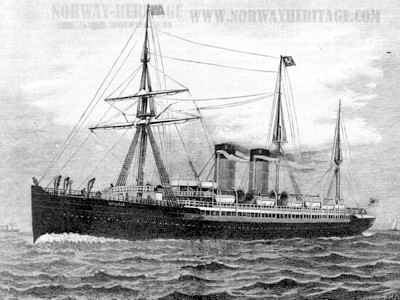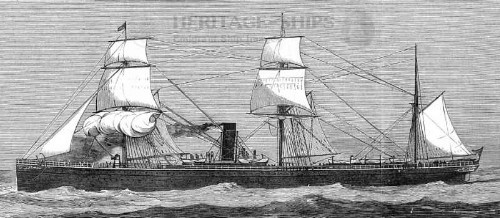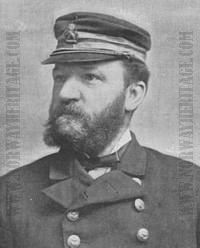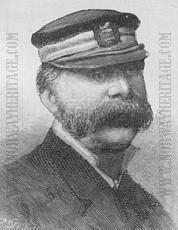The London Illustrated News, Jan 7, 1893 - transcribed by BÝrge Solem 2006
A stirring story of the sea, such as has often delighted the admirers of Mr. W. Clark Russell, could be framed on the experiences of the Cunard steamship Umbria, which safely reached New York, after considerable anxiety for her safety, early on Saturday morning, Dec. 31. [1892] In these days of rapid voyages across the "herring-pond," the fact that the Umbria left Queenstown on Dec, 18 and only reached New York thirteen days later is an occasion for alarm; twenty years ago it would have been a cause of wonder! The trip had proceeded without any unusual incidents until Friday, Dec. 23, when, to quote from an abstract of the log, "in lat. 42 48 N., long. 57 17 W., a strong breeze was blowing from the north-west. At 5.25 p.m. the engines stopped, owing to the shaft breaking at the thrust block. The wind and sea were moderate. "The repairs to the shaft lasted four days, and took place off the coast of Newfoundland. For seventy-five miles the Umbria was towed by the Hamburg-American steamship Bohemia, but in a heavy gale on Christmas Eve the cable parted and the Umbria drifted away. It has since been discovered that the hawser by which the latter was towed was cut on board the Bohemia. She was sighted by a Wilson liner, which, however, could not take her in tow, and also by the Manhansett and by the Gallia. In return to the Umbria's signal "Disabled, stand by," the Gallia only replied, "Can't stand by, carrying mails."
Considering that the Umbria herself was carrying 1300 bags and other very important cargo, it is not surprising that she signaled, as a parting shot, "We hold you responsible." The Gallia arrived at Queenstown on Jan. 2, and, of course, the captain was at once questioned as to his reported action, but declined to give any information, except to the Cunard Company. A plausible explanation is found in the idea that the Umbria did not convey by her signals any exact mention of danger. However, we shall probably hear more on this point in a day or two. Meanwhile, Messrs. T. Wilson, Sons, and Co., Limited, have hastened to contradict the statement that their steamer Galileo declined to tow the Umbria by reason of insufficient coal. They have been informed that the Umbria declined assistance. The nature of the fracture which temporarily disabled, the steamship rendered the work of repairing it somewhat lengthy, but there is hearty praise accorded to the engineers for the efficiency with which they managed it. Chief Engineer Tomlinson had to undertake the heavy task of mending an awkward breakage while the vessel was rolling and pitching in a heavy sea. To our naval readers it will be interesting to learn that he drilled three keyways out of solid steel in the collars, and fitted steel bolts of five inches in diameter into them. Mr. Tomlinson had to shorten them and reconstruct the massive nuts. After two hours' trial on the 28th, one of the connecting bolts had its head wrenched off. This was repaired, and the Umbria proceeded to its destination under favorable conditions. The method of meeting the mechanical difficulties has received high approbation from experts. The broken shaft had no support for 26 ft., and men were engaged for three days continuously working with drills and chisels. A subscription of £100 was raised for the engineering staff by the grateful passengers, who appear, under the unfortunate circumstances, to have behaved with exemplary common-sense. Varying the condition of Lotos-land, "in which it seemed always afternoon," the ladies on board the Umbria continually improvised five o'clock teas, and "walked about the cabins with the utmost serenity, and were the life and soul of the dinner-tables." An enthusiastic passenger further states that "we could not have managed without them, if the whole truth be told." So there is one other achievement to be added to the articles which have lately appeared on "Women's Work in 1892."
Captain McKay and his officers seem to have acted with excellent judgment through the trying conditions under which they controlled the ship. Bulletins as to the state of affairs were constantly exhibited, and only the usual minority of foolish people created any excitement. The scene on the Umbria's arrival at New York was most exhilarating. As soon as the ship entered the harbor all the passengers went to the captain and heartily congratulated him. Hundreds of persons had assembled at the wharf to greet their friends on board and learn the story of their experiences. Among those who awaited the steamer's arrival were two young Englishmen whose brides were on board the Umbria. They had simultaneously visited the Rev. Walter Garner, who was to conduct the weddings, and became acquainted with each other. The double wedding has now been celebrated, acquiring extra interest from the circumstances. And thus, as in the story-books, we are able to end our narrative with wedding-bells. The passengers will have the heartiest congratulations on their safety, and the officers are also entitled to warm praise for their behavior, although they will doubtless only claim that they "did their duty and nothing more." The whole story may be summed up in a medley of Shaksperian titles. It is the "Winter's Tale" of a "Comedy of Errors" in a "Tempest," to which, fortunately, there is the conclusion of "All's Well that Ends Well." In many a home "Christmas Day on the Umbria" will be a popular item in conversation round the fireside for many a day.
http://www.norwayheritage.com/



